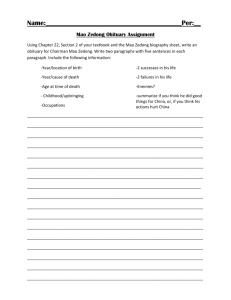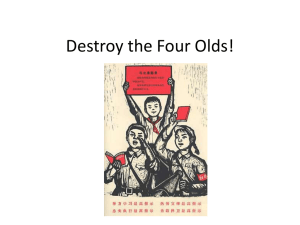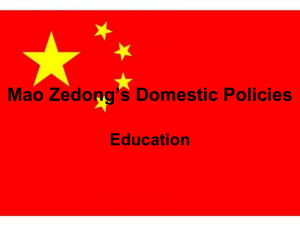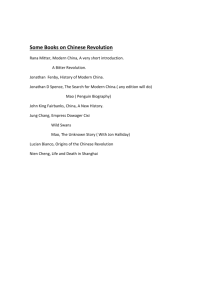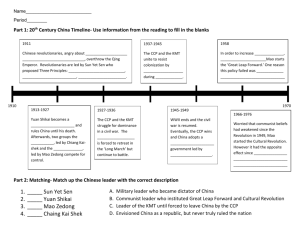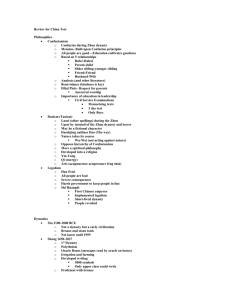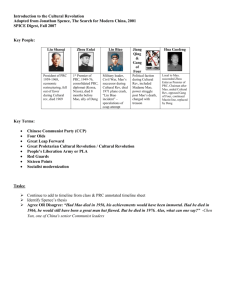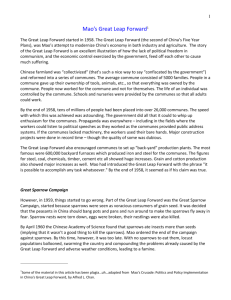Name_____________________ World History 10 The “Great Leap
advertisement
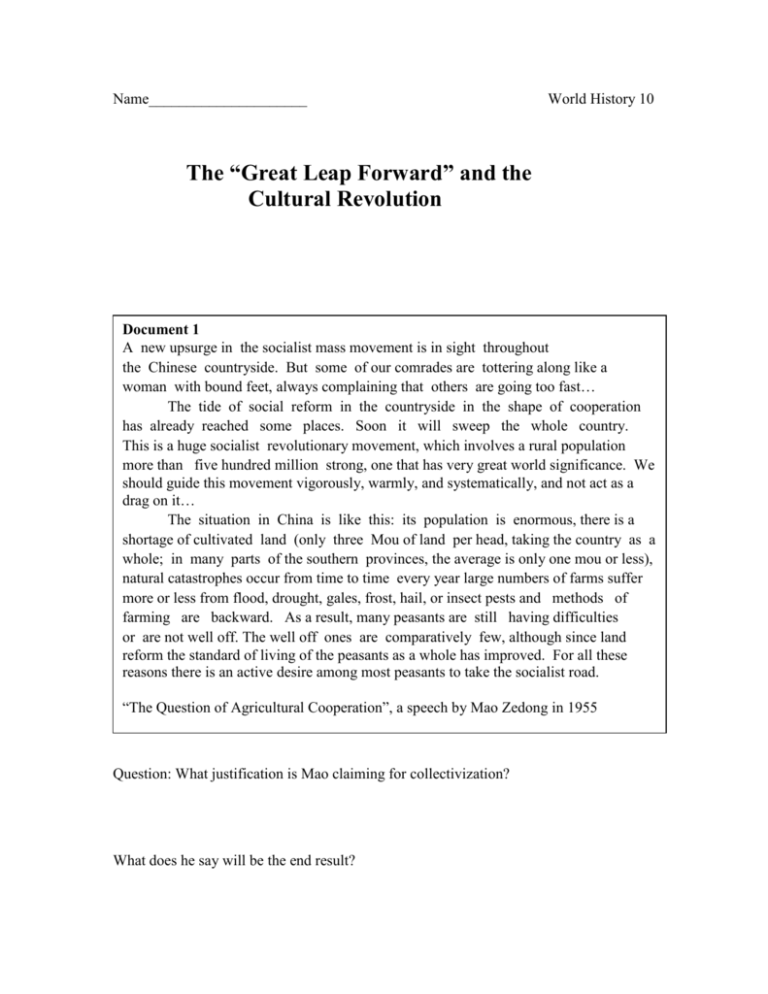
Name_____________________ World History 10 The “Great Leap Forward” and the Cultural Revolution Document 1 A new upsurge in the socialist mass movement is in sight throughout the Chinese countryside. But some of our comrades are tottering along like a woman with bound feet, always complaining that others are going too fast… The tide of social reform in the countryside in the shape of cooperation has already reached some places. Soon it will sweep the whole country. This is a huge socialist revolutionary movement, which involves a rural population more than five hundred million strong, one that has very great world significance. We should guide this movement vigorously, warmly, and systematically, and not act as a drag on it… The situation in China is like this: its population is enormous, there is a shortage of cultivated land (only three Mou of land per head, taking the country as a whole; in many parts of the southern provinces, the average is only one mou or less), natural catastrophes occur from time to time every year large numbers of farms suffer more or less from flood, drought, gales, frost, hail, or insect pests and methods of farming are backward. As a result, many peasants are still having difficulties or are not well off. The well off ones are comparatively few, although since land reform the standard of living of the peasants as a whole has improved. For all these reasons there is an active desire among most peasants to take the socialist road. “The Question of Agricultural Cooperation”, a speech by Mao Zedong in 1955 Question: What justification is Mao claiming for collectivization? What does he say will be the end result? Document 2 In the early 1950’s China chose to model its Socialist Economy after that of the Soviet Union. The Soviet Model called for capital-intensive development of heavy industry, with the capital to be generated from the agricultural sector of the economy. The state would purchase grain from the farmers at low prices and sell it, both at home and on the export market, at high prices. In practice, agricultural production did not increase fast enough to generate the amount of capital required to build up China’s industry according to plan. Mao Zedong (1893-1976) decided that the answer was to reorganize Chinese agriculture by pushing through a program of cooperativization (or collectivization) that would bring China’s small farmers, their small plots of land, and their limited draught animals, tools, and machinery together into larger and, presumably, more efficient cooperatives. The farmers put up resistance, mostly in the form of passive resistance, lack of cooperation, and a tendency to eat animals that were scheduled for cooperativization. Many of the Communist Party leaders wanted to proceed slowly with cooperativization. Asia for Educators, Columbia University http://afe.easia.columbia.edu/ps/cup/mao_zedong_agricultural_cooperation.pdf Document 3 Man Starving as a result of the “Great Leap Forward” – 1958-1961 Question: What was the actual end result of the Great Leap Forward, according to these documents two and three? What are some of the reasons that document three gives for this? Document 3 Mr Dikötter, who has been studying Chinese rural history from 1958 to 1962, when the nation was facing a famine, compared the systematic torture, brutality, starvation and killing of Chinese peasants to the Second World War in its magnitude. At least 45 million people were worked, starved or beaten to death in China over these four years; the worldwide death toll of the Second World War was 55 million. Mr Dikötter is the only author to have delved into the Chinese archives since they were reopened four years ago. He argued that this devastating period of history – which has until now remained hidden – has international resonance. "It ranks alongside the gulags and the Holocaust as one of the three greatest events of the 20th century.... members of the rural farming communities were seen by the Party merely as "digits", or a faceless workforce. For those who committed any acts of disobedience, however minor, the punishments were huge. State retribution for tiny thefts, such as stealing a potato, even by a child, would include being tied up and thrown into a pond; parents were forced to bury their children alive or were doused in excrement and urine, others were set alight, or had a nose or ear cut off. One record shows how a man was branded with hot metal. People were forced to work naked in the middle of winter; 80 per cent of all the villagers in one region of a quarter of a million Chinese were banned from the official canteen because they were too old or ill to be effective workers, so were deliberately starved to death. “Mao's Great Leap Forward 'killed 45 million in four years”, The Independent, April 2013 Question: What sort of methods did the communist party use to enforce collectivization and what does that tell you about how the common peasants viewed the “Great Leap Forward”? Document 4 With no personal knowledge of metallurgy, Mao encouraged the establishment of small backyard steel furnaces in every commune and in each urban neighborhood. Mao was shown an example of a backyard furnace in Hefei, Anhui in September 1958 by provincial first secretary Zeng Xisheng. The unit was claimed to be manufacturing high quality steel (though in fact the finished steel had probably been manufactured elsewhere). Huge efforts on the part of peasants and other workers were made to produce steel out of scrap metal. To fuel the furnaces the local environment was denuded of trees and wood taken from the doors and furniture of peasants' houses. Pots, pans, and other metal artifacts were requisitioned to supply the "scrap" for the furnaces so that the wildly optimistic production targets could be met. Many of the male agricultural workers were diverted from the harvest to help the iron production as were the workers at many factories, schools and even hospitals. Although the output consisted of low quality lumps of pig iron which was of negligible economic worth, Mao faith in the power of the mass mobilization of the peasants. http://en.wikipedia.org/wiki/Great_leap_forward#Backyard_furnaces Question: What are some of the problems with the use of backyard furnaces (info from document and thinking beyond it)? How were these supposed to help achieve the goals of the “Great Leap Forward”? What does this fixation on backyard furnaces show about Mao as a leader? Document 5 In the afternoon of August 5, 1966, some tenth-grade students at the Girls Middle School attached to Beijing Teachers University started beating the black gang, a group comprised of three vice-principals and two deans (there was no principal). Many students came to join in. The students splashed ink on the clothes of these five, forced them to wear high hats, hung boards with their names crossed out by red on their necks, forced them to kneel on the ground, hit them with nail-spiked clubs, scalded them with boiling water, and so on. After three hours of torture, the first viceprincipal, Bian Zhongyun, lost consciousness and was put into a garbage cart. Two hours later she was sent to the hospital across the street. There, she was later found to have been dead for some time. Another vice-principal, Hu Zhitao, suffered bone fractures. The others were also severely injured. Bian Zhongyun, fifty years old, who had been working for this middle school for seventeen years, was the first educator to be beaten to death by students in Beijing during the Cultural Revolution. Large-scale violence had, however, begun earlier at the Middle School attached to Beijing University. Liu Meide was a vice-principal and a chemistry teacher at this middle school. On July 31, on the day the working group that was in charge of the school in June and July received the order to withdraw from school but had not yet left, a group of students launched a violent action against her. They hacked Liu’s hair, put dirt into her mouth, and beat her. Liu was forced to crawl on the playground and repeatedly say: I am Liu Meide. I am a poisonous snake. One day in August, she was ordered by the students to climb on a table and kneel there. A student placed one foot on her back, posing as per Mao Zedong's description of how to struggle against landlords: force them down on the ground and then place one foot on them. After a journalist of the Beijing Daily took a photograph, the student kicked Liu from the table to the ground. Liu was pregnant at that time. Her baby died from prenatal injuries soon after the birth. Many teachers at this school were tortured during the same period. On August 4 at Beijing Fourth Middle School, more than thirty teachers and administrators were attacked on the playground. Students poured ink on them, beat them, kicked them, and tore their clothes. After this incident, two teachers who were insulted committed suicide. At the Middle School attached to Qinghua University, the birthplace of the Red Guards, Wan Bangru, the principal, and his vice-principal, Han Jia'ao, were forced to put a piece of black cloth on the front of their shirts, on which were written in white characters: first head of the black gang and second head of the black gang, respectively. Beginning from early August, they were beaten black-and-blue many times. Their hair was cut raggedly. Wan's kidneys were seriously damaged. One day the students of class 6401 (the eighth grade) forced Han Jia'ao to kneel on the floor of their classroom and took turns beating him, one after another, with a club, whip, or leather belt for more than an hour, and then burned Han's hair. Some teachers were forced to beat each other and were told, If you don't beat each other, we will beat you both. A female staff member, Gu Hanfen, not only had half of her head shaved, but was also blinded in one eye as a result of being beaten. In late August, the violent beatings expanded to younger teachers, and even to some students. At midnight of August 26, 1966, having been beaten and insulted for the whole evening at a “struggle meeting”, a twenty-six-year-old chemistry teacher named Liu Shuhua committed suicide by jumping from the top of the school's chimney. On August 17, 1966, at Beijing 101st Middle School, students tortured more than ten teachers. They forced teachers to crawl on a path paved with coal cinders until knees and palms bled. They whipped their instructors with copper-buckled belts. Some female teachers suffered having half of their heads shaved, in a hairstyle called yinyang head. The painting teacher, Chen Baokun, was beaten badly and then drowned in a fountain. Question: If these kids are being influenced by the ideas of Mao’s communist party, what does it say about the party’s attitude toward intellectualism? Why would this be the case? What do these teachers represent and what threat might learning pose to Mao’s communist state? Document 6 Text Reads: “Destroy the old world; build a new world," a Red Guard crushes the crucifix, Buddha and classical Chinese books with his hammer, circa 1967 Question: Based on this, what are some characteristics of the new world that Mao wants to create? Document 7 Question: What does this tell you about how Mao viewed himself and the role he would play? Do you see any similarities to other leaders you have studied? If so, what? Document 8 Question: How might this encourage support of the Communist Party and Mao? Document 9 Question: What does this document tell you about the future Mao sees for China after the Cultural Revolution? Why? Question: Is this different from during the “Great Leap Forward” a few years before? If so, how?
